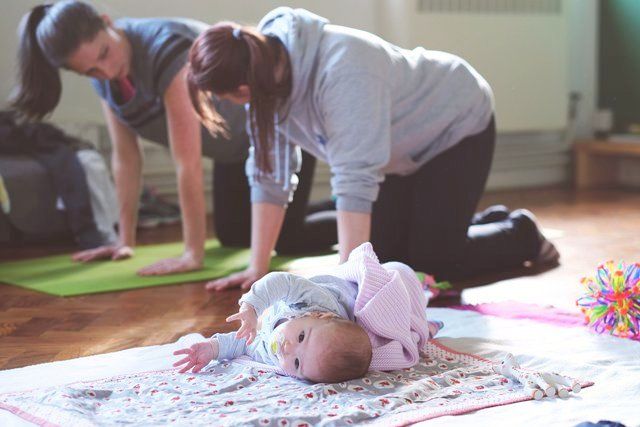I often get asked what is the exercise form that you would recommend following having a baby. The first answer every single time is Pilates.
Why Pilates?
For me Pilates has many benefits;
- it’s controlled
- gives you time to think
- makes you work properly
- improves posture
- makes you stronger and more toned
- helps to prevent, manage and rehabilitate injuries
With so many benefits why isn’t everyone doing Pilates?
The Pregnant Body
More specifically, for our postnatal bodies, pilates helps to reconnect you to your pelvic floor and deep abdominals- not that they disconnected! During pregnancy the pelvic floor has to support the growing baby and the abdominals are put on a permanent stretch as the baby grows. At 30plus weeks they also separate to allow this growth to continue. During labour the pelvic floor can go through some trauma during a vaginal birth and of course the abdominals assist to help get the baby out. During a section the abdominals are pulled apart to reach the baby before we are stitched back up.
Our posture would also have changed to accommodate the shift in gravity due to the growing baby, this usually presents it’s self as a bigger low back curve. Feet can flatten and widen, calves tighten and shoulders become tense.
Needless to say it takes a bit of a battering!
A note on hypnobirthing and breathing
Something else to note is that during labour we are taught to push down as we breath out. This creates pressure and as such assists in labour. Usually during hypnobirthing and other pregnancy courses, this is also taught. Obviously, this is to help as much as possible during labour. The problem arises outside of labour, when this may become a normal breathing pattern. Most of the time this isn’t a problem, but when adding in loading, such as picking up something heavy, it can lead to extra strain on the pelvic floor and abdominals.
Post birth
Unfortunately much of the same is true in terms of what our bodies look like after birth. Back, neck and shoulder pain due to feeding and sleeping in just about any awkward posture possible, thumb pain is also a thing, as knee pain. Plus we have the added issue of tummy muscles and pelvic floors being stretched and going through birth to consider.
This all sounds so grim doesn’t it!?
Early Days of Training
It’s not all doom and gloom however, and most of these problems are a matter of retraining our bodies again. This is where Pilates is king!
In the very early days just working on your pelvic floor and breathing is all you need to do. Go out for plenty of walks and just take note of your body- how does it feel? Any areas of tightness? Do it feel tight or loose or just different? This is all good information for later on. Walking is gentle and kind on the early postnatal body for sure.
Once you have hit your ‘safe’ week (6 weeks virginal, 10-12 weeks C-section), you can begin to start exercising again. Now this may seem like a pass to go in full hog at the gym, but I’d discourage jumping back in with two feet just yet!
Postnatal Pilates
In the early days we want to start addressing all the above possibilities as well as giving you something that focuses on YOU and NOT the baby.
In a postnatal class, the focus is getting you reacquainted with your pelvic floor and deep abdominals again. Making sure you can locate and activate them effectively, is important before you progress to other more challenging movements. From there getting your body to move is the next most important step. Lengthening the muscles that have become tight and restricted will not only allow to move better and improve your postures but it will make you feel better. Finally the strength comes in, challenging the core muscles with movements such as single leg stretch and roll down prep.
These all need to be done with control and precision to make sure you aren’t overloading the body.
Your body is unique, to yourself
A key thing to remember is that everyone’s body heals a different rate, has responded to pregnancy and birth differently and has different daily challenges. Not one body is the same. Some may have a bigger or smaller tummy gap, but they will vary in how much tension there is, where the gap is, what’s keeping it open, So results on a timescale will vary, but that’s ok!
The low down
So unlike other types of fitness, Pilates for the early (or not so early) postnatal body has massive benefits. It will teach you how to reconnect, and properly, to your core muscles. Provide you with the time and space to work on them before loading the body with more challenge. It will help to lengthen those short and tight muscles, allowing you to move and fell better. In turn that will lead to a better posture and more effective movement pattern, which also helps to reduce risk of injury later on. It can help to strengthen areas in your body that need it, helping to prep you for future more intensive or demanding exercise.
Postnatal pilates is like your prehab, its 100% worth investing your time into it. But don’t just finish your 6 weeks and stop, keeping going with , when you start to introduce running, jumping, lifting and general life, pilates will be there to help you along the way.
Why not sign up to our postnatal pilates in Bristol, based within our little studio in BS4. Currently 9:30am Wednesdays? You can book your class here


